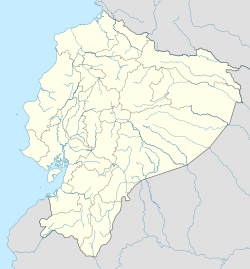Saraguro people
| Saraguro | |
|---|---|
| Town and ethnic group | |
| Location in Ecuador | |
| Coordinates: 3°37′20″S 79°14′23″W / 3.62222°S 79.23972°WCoordinates: 3°37′20″S 79°14′23″W / 3.62222°S 79.23972°W | |
| Elevation | 2,518 m (8,261 ft) |
| Climate | Cfb |
The Saraguro people are an ethnic group, most of whom live in Saraguro Canton in the Loja Province of Ecuador. Although most now speak Spanish, Kichwa, a Quechua dialect, is still spoken in the 21st century. Likewise, the Saraguro have retained much of their land, customs and traditional dress, numbering about 30,000.
The Saraguro may be the descendants of people re-settled from distant regions in the Inca Empire in the 15th and early 16th century.
In the 1460s the Inca empire conquered the Saraguro area. The pre-Inca people may have been the barely-known Palta or the Cañari. The ancestors of the modern-day Saraguro people, according to oral traditions, were moved to Saraguro by the Incas from other areas, possibly the Colla or other people from the Lake Titicaca and Cuzco regions. The Incas had a policy of forcibly moving people from one region of the empire to another, thereby diversifying the population and dispersing possible opposition to their rule. The resettlement policy was called mitma. The numbers resettled were large, estimated to be up to 80 percent of the population of some provinces.
One Spanish document says that the ancestors of present-day Saraguros were elite soldiers in the Inca army. This statement is bolstered by the fact that the Saraguros live along the Inca road that stretched from Cuzco to Tumebamba (the northern capital of the Incas), and onward to Quito and thus occupied an important link for Inca communications and control of the empire. The town of Saraguro, however, seems to have been founded by the Spanish rather than the Incas although a number of Inca ruins are in the nearby area.
Whatever the facts about their origins. Saraguro in the 20th century celebrate their Inca heritage. Oral traditions ascribes the black clothing typical of the Saraguro as a sign of mourning for the death of the Inca Emperor Atahualpa. Schools have been named after Inca emperors, Inca customs recreated, Inca architecture copied, and efforts made to preserve the Kichwa language.
...
Wikipedia

